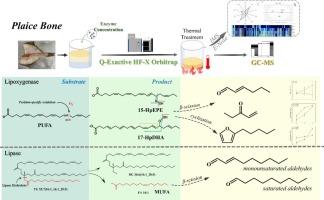脂肪酶和脂氧合酶介导的复杂脂质系统分化和靶向催化机制
IF 9.8
1区 农林科学
Q1 CHEMISTRY, APPLIED
引用次数: 0
摘要
复杂脂质系统中酶介导反应中反应速率分化、催化前体分化和终产物分化的调控是风味调控研究的一个关键领域。利用鲽骨油(PBO)、脂肪酶和脂氧合酶建立了多层脂质氧化模型,研究了不同脂质氧化差异及其风味形成模式。脂肪酶处理导致非氧化挥发性化合物和饱和醛的水平升高,而脂肪加氧酶处理增加了含氧化合物,特别是(E)-2-己烯醛、1-戊烯-3- 1和2-戊基呋喃。脂肪酶水解甘油三酯显著提高了单不饱和脂肪酸的浓度。脂氧合酶催化PUFAs在ω-6碳位上形成位置特异性氧化产物,如15-hydroperoxy-EPA和17-hydroperoxy-DHA。这些酶处理改变了脂质谱,导致不同的风味形成模式。这项研究为了解食物中酶介导的挥发性物质变化的机制提供了有价值的见解。本文章由计算机程序翻译,如有差异,请以英文原文为准。


Mechanism of differentiated and targeted catalysis in complex lipid system under lipase and lipoxygenase mediation
The regulation of reaction rate differentiation, catalytic precursor differentiation, and end-product differentiation during enzyme-mediated reactions within complex lipid systems is a key area of research in flavor regulation. A multilayer lipid oxidation model, utilizing Plaice bone oil (PBO), lipase, and lipoxygenase, was employed to investigate oxidation differences between various lipids and corresponding flavor formation patterns. Lipase treatment resulted in higher levels of non‑oxygenated volatile compounds and saturated aldehydes, whereas lipoxygenase treatment increased oxygenated compounds, particularly (E)-2-hexenal, 1-penten-3-one, and 2-pentylfuran. The hydrolysis of triglycerides by lipase significantly raised the concentration of monounsaturated fatty acids. Lipoxygenase catalyzed the formation of position-specific oxidation products at the ω-6 carbon position of PUFAs, such as 15-hydroperoxy-EPA and 17-hydroperoxy-DHA. These enzymatic treatments altered the lipid profile, leading to distinct flavor formation patterns. This study provides valuable insights into the mechanisms underlying enzyme-mediated volatile substance variations in food.
求助全文
通过发布文献求助,成功后即可免费获取论文全文。
去求助
来源期刊

Food Chemistry
工程技术-食品科技
CiteScore
16.30
自引率
10.20%
发文量
3130
审稿时长
122 days
期刊介绍:
Food Chemistry publishes original research papers dealing with the advancement of the chemistry and biochemistry of foods or the analytical methods/ approach used. All papers should focus on the novelty of the research carried out.
 求助内容:
求助内容: 应助结果提醒方式:
应助结果提醒方式:


